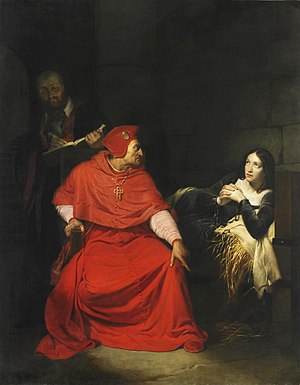
Henry Beaufort was an English Catholic prelate and statesman who held the offices of Bishop of Lincoln (1398), Bishop of Winchester (1404) and cardinal (1426). He served three times as Lord Chancellor and played an important role in English politics.

Pierre Cauchon was a French Catholic prelate who served as Bishop of Beauvais from 1420 to 1432. He was a strong partisan of English interests in France during the latter years of the Hundred Years' War. He was the judge in the trial of Joan of Arc and played a key role in her execution. The Catholic Church overturned his verdict in 1456.
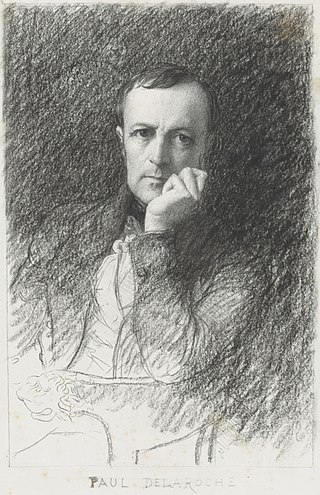
Hippolyte-Paul Delaroche was a French painter who achieved his greater successes painting historical scenes. He became famous in Europe for his melodramatic depictions that often portrayed subjects from English and French history. The emotions emphasised in Delaroche's paintings appeal to Romanticism while the detail of his work along with the deglorified portrayal of historic figures follow the trends of Academicism and Neoclassicism. Delaroche aimed to depict his subjects and history with pragmatic realism. He did not consider popular ideals and norms in his creations, but rather painted all his subjects in the same light whether they were historical figures like Marie-Antoinette, figures of Christianity, or people of his time like Napoleon Bonaparte. Delaroche was a leading pupil of Antoine-Jean Gros and later mentored a number of notable artists such as Thomas Couture, Jean-Léon Gérôme, and Jean-François Millet.

François Joseph Heim was a French painter known especially for his history paintings and portraits.
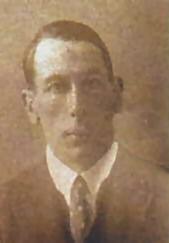
Charles André Mare (1885–1932), or André-Charles Mare, was a French painter and textile designer, and co-founder of the Company of French Art in 1919. He was a designer of colorful textiles, and was one of the founders of the Art Deco movement.

Antoine Auguste Ernest Hébert was a French academic painter.
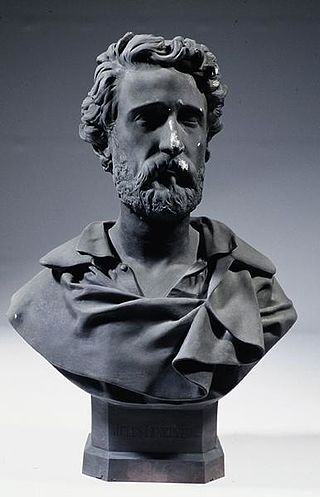
Jules-Eugène Lenepveu was a French painter.

Louis Candide Boulanger was a French Romantic painter, pastellist, lithographer and a poet, known for his religious and allegorical subjects, portraits, genre scenes.

Fleury François Richard, sometimes called Fleury-Richard, was a French painter of the Lyon School. A student of Jacques-Louis David, Fleury-Richard and his friend Pierre Révoil were precursors of the Troubadour style.
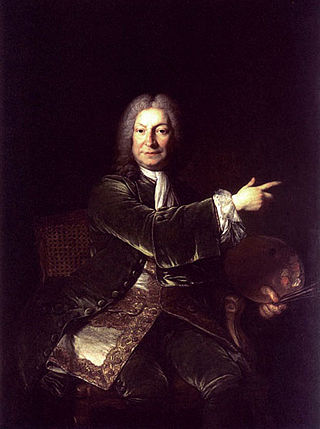
Robert Le Vrac de Tournières was a French painter. After the Second World War, a street in the new Saint-Paul district of his home city of Caen was named rue Robert Tournières.

Féréol Bonnemaison was a French portrait painter, lithographer, restorer, and art dealer.

Robert Antoine Pinchon was a French Post-Impressionist landscape painter of the Rouen School who was born and spent most of his life in France. He was consistent throughout his career in his dedication to painting landscapes en plein air. From the age of nineteen he worked in a Fauve style but never deviated into Cubism, and, unlike others, never found that Post-Impressionism did not fulfill his artistic needs. Claude Monet referred to him as "a surprising touch in the service of a surprising eye".

Anicet Charles Gabriel Lemonnier was a well-known French painter of historical subjects who was active before, during and after the French Revolution.

Cinq-Mars' Farewell to Marie d'Entraigues or The Kiss Goodbye is a painting by Claudius Jacquand in 1836, which is kept at the Musée des beaux-arts de Lyon.

Louise-Joséphine Sarazin de Belmont (1790–1871) was a French landscape painter and lithographer.

Paul Claude-Michel Carpentier was a French portrait, genre, history painter and author. He studied with Jean-Jacques Lebarbier (1738–1826) and briefly with Jacques-Louis David (1748–1825). Until 1824 he exhibited at the Salons under his family name LeCarpentier, but after 1824 shortened his last name to Carpentier.

Zacharie Charles Landelle was a French painter who specialized in portraits. He is best known for his Orientalist works.

Cromwell with the Coffin of Charles I is a partially-varnished c. 1831 watercolour by Eugène Delacroix, now in the Département des Arts graphiques of the Louvre in Paris.

Joan of Arc is an oil on canvas painting by Jules Bastien-Lepage, from 1879. It was exhibited at the Exposition Universelle in Paris in 1889. It his held in the Metropolitan Museum of Art, in New York.
Josette Hébert-Coëffin was a French sculptor, medallist and a recipient of a 1937 Guggenheim Fellowship.
